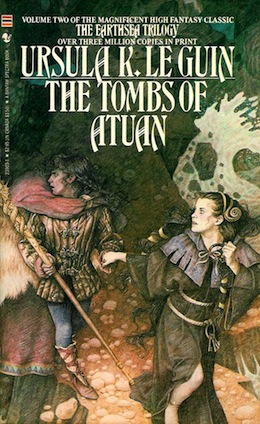In this series, Ilana C. Myer is revisiting the fantasy classics that first shaped her love of the genre, and evaluating them with new eyes. Sometimes the best way to comprehend the nature of a journey, when you’re in the middle, is to look back to its beginning…
This is an extraordinary book. It feels too obvious to say that: there are few positions one might take at lesser risk than one of praise for Ursula Le Guin. But sometimes the works most widely praised are the least talked about for what they actually do. The Tombs of Atuan captures the essence of great fantasy in a way few other works of fantasy can ever hope to match. If the purpose of fantasy is to explore the interior—the inner space of the human soul—no one has done this with greater effectiveness than Le Guin does in this novel.
I loved this book as a fourteen-year-old, appreciating the magnificent writing and Le Guin’s thematic approach to fantasy—which has remained important to me. But reading it decades later, I was moved to tears for the first time. There are lessons that only come with time, no matter how precocious a teenager or how seasoned a reader one is; one of these is an understanding of the way in which some wounds might leave a mark for years in the future, perhaps for as long as we live, and that “Time heals everything” is a catchphrase invented by soothsayers in the self-help business. Tenar’s painstaking return from her transformation into Arha is depicted with the exhilarating revelation of freedom attained, but also an indelible sense of loss. She may escape the Labyrinth, but she will always retain a piece of the Labyrinth in her heart.
The Tombs of Atuan is, in atmosphere and tone, almost an exact reversal of its predecessor, A Wizard of Earthsea. My memory of the latter is dominated by sunlight on sparkling water. No darkness at all. Ged’s journey on the open sea to various islands, while technically driven by a quest, is one of bright-lit confidence. Tombs is the exact inverse of this: a journey through a dark, musty Labyrinth, in which a single flash of light can shake the protagonist to the core of her soul. Surely it’s not surprising that the male journey is less interior, with less complexity, since ultimately Ged’s struggle need not be with the world, but only within himself.
Symbolism is an underpinning of this story—but not allegory; the contrast of light and dark, the grim Tombs, and of course the Labyrinth, can be interpreted in many ways at once. This symbolism informs the language on every level. It is of course most obvious in Tenar’s first encounter with Ged: deep underneath the Tombs, a place she has only seen in darkness, he shines the forbidden light of his staff and the place revealed to her eye is “immense, with glittering roof and walls, sparkling, delicate, intricate, a palace of diamonds, a house of amethyst and crystal, from which the ancient darkness had been driven out by glory.”
There are few ways to understand this, probably. And there is a tendency in literary criticism to trot out the author’s belief system and politics, with a wink and a nod, and use them to reduce everything: in this case, Le Guin’s known belief in Taoism can be applied to each instance of dark and light, just as knowledge of Tolkien’s Catholicism and experience of World War I often becomes a game of find-the-allegory. Such criticism may make for solid academic papers but it is, to borrow a phrase from none other than Tad Williams, “a knife in the heart of wonder.”
In any case, the light in the cavern: what could have been banal—the story of a worldly young man teaching a sheltered, religious creature about her sensuality and desires—is of too many dimensions to be contained within the bounds of such a banal interpretation. For one thing, Ged never displays that quality so prized in romances of that sort—rakish charm. Throughout, the quality most prominently on display from Ged is one that’s much less romantic, yet of surpassing value: decency. He does not charm his way into the heart of Tenar; he is, truly, that light in the caverns, and his purpose is not to illuminate his own good qualities, but hers. He acts in humble deference to her journey and transformation. What he brings out in Tenar is not sexual attraction, but an instinct for goodness and decency that had been buried in the stagnant death games of the Tombs.
And those Tombs, their rituals, the Labyrinth with its doors and treasures and rusted keys—these are a world unto themselves. Le Guin so skillfully illustrates the way religious conviction can permeate and give meaning to a life. The world in which Tenar is initiated is one of genuine and terrifying power. The Tombs are animated by real malevolence; the secrets of the Labyrinth are manifold and terrible. To leave is not simple at all—Tenar’s escape is layered, far more protracted than I’d remembered. Even after she escapes with Ged, the shadow calls back to her several times, taking shape as trauma and grief. This was, perhaps, the most astonishing part of the novel to revisit. Light, love, and healing—these things are all powerful and real; but to give them their due, one must show the truth about the forces they stand against. “To light a candle is to cast a shadow,” the Le Guin credo goes, and in The Tombs of Atuan, light and shadow are granted their full, incalculable weight.
Ilana C. Myer has written about books for the Globe and Mail, the Los Angeles Review of Books, the Huffington Post, and Salon. Her first novel, Last Song Before Night, an epic fantasy about poets and dark enchantments, was published by Tor in October 2015.










